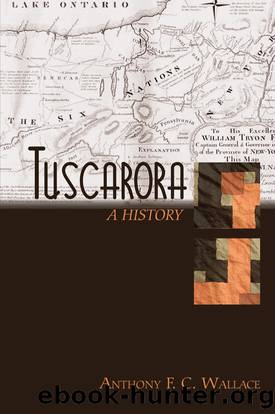Tuscarora by Anthony F. C. Wallace

Author:Anthony F. C. Wallace [Wallace, Anthony F. C.]
Language: eng
Format: epub
Tags: Social Science, Ethnic Studies, American, Native American Studies, History, Indigenous Peoples of the Americas, Anthropology, General
ISBN: 9781438444314
Google: oCkL4hEzPlQC
Publisher: SUNY Press
Published: 2012-11-15T05:39:21+00:00
The Reservoir
At Tuscarora, the event that most perfectly embodies the elements of siege has been not a fraudulent cession but an outright seizure of land for the building of a reservoir for the hydroelectric Niagara Power Project. The reservoir inundated nearly a square mile of the Tuscarora reservation.
Electric power generating stations, using the waters from Lake Erie diverted through tunnels past Niagara Falls and down the steep slope of the escarpment beside the Niagara River to turn the turbines, had been in place at sites below the Falls on both sides of the river since the late nineteenth century. By the middle of the twentieth century these power plants had become obsolete and by 1950, when a new treaty with Canada provided for the sharing of the waters was in place, plans were already being made to replace them with more modern facilities. During the negotiations over a new power plant, the old power station on the American side collapsed, leaving an urgent need for a replacement to supply electricity to the burgeoning chemical and metal-working industries that had grown up on the Niagara frontier depending on the availability of cheap and copious electric power. A new design was produced by the New York Power Authority, under the leadership of the visionary Robert Moses; it called for the construction of tunnels from the shore of Lake Erie, above the Falls, to the new Power Project at the base of the escarpment, below the rapids of the Niagara River. The water would be impounded in a giant reservoir of over four-and-one-half square miles atop the escarpment, to be released to the station below in a diurnal cycle that would ensure the uninterrupted movement of the turbines at night when the demand for power diminished. Most of the land required for the reservoir would be taken from White communities but a portion, in the original plan on the order of two square miles, would be located on the Tuscarora Reserve, as would a swath of territory over which transmission lines would stretch to supply electricity to consumers throughout western New York. The New York Power Authority negotiated contracts with landholders in the path of the project to compensate them for the losses they would be expected to incur. Those who had a stake in the condemnation proceedings included public institutions like Niagara University under whose campus the great tunnel system passed, local municipalities, businesses, and private householders. Most promptly came to terms. But the Tuscarora Nation, through its Chiefs' Council, refused, objecting that the proposed reservoir, even under a reduced loss of less than a square mile, would deprive the Tuscaroras of 10 percent or more of their hard-won homeland. They argued that their reservation was exempt from such seizure, citing treaties and agreements that had been in place as the law of the land for up to one hundred eighty years, and arguing that a feasible redesign of the reservoir could place it outside the reserve.
The issue proceeded to court. The state asserted its right to condemn Tuscarora land under the right of eminent domain.
Download
This site does not store any files on its server. We only index and link to content provided by other sites. Please contact the content providers to delete copyright contents if any and email us, we'll remove relevant links or contents immediately.
Born to Run: by Christopher McDougall(7065)
The Leavers by Lisa Ko(6912)
iGen by Jean M. Twenge(5367)
Sapiens by Yuval Noah Harari(5294)
The Kite Runner by Khaled Hosseini(5085)
Spare by Prince Harry The Duke of Sussex(5074)
Machine Learning at Scale with H2O by Gregory Keys | David Whiting(4187)
Bullshit Jobs by David Graeber(4097)
Never by Ken Follett(3795)
Goodbye Paradise(3728)
Livewired by David Eagleman(3685)
Fairy Tale by Stephen King(3220)
A Dictionary of Sociology by Unknown(3031)
Harry Potter 4 - Harry Potter and The Goblet of Fire by J.K.Rowling(2990)
The Social Psychology of Inequality by Unknown(2941)
The Club by A.L. Brooks(2862)
Will by Will Smith(2794)
0041152001443424520 .pdf by Unknown(2784)
People of the Earth: An Introduction to World Prehistory by Dr. Brian Fagan & Nadia Durrani(2702)
